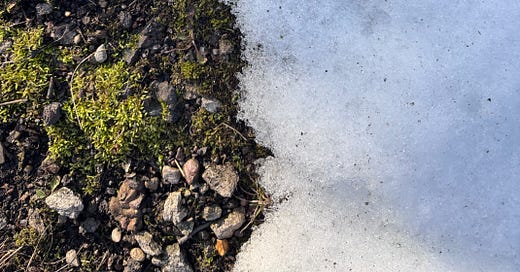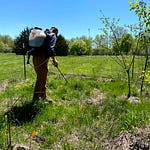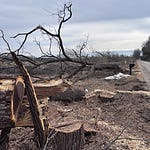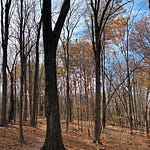This is the newsletter version of Sara by the Season, where I explore what is piquing my curiosity as I try to lean into nature’s wisdom and rhythms. You can listen to me read you the newsletter by hitting play above - or you can click the little link above and to the right to play in your favorite podcast player.
If you know someone who would like this sort of thing, I’d be so grateful if you would share it.
A few years ago, I had a strange experience with Mary (as in the mother of Jesus), but also maybe Mary Magdalene. Things are still unclear, and that isn’t what I want to write about today anyway. This experience led me to read several books about Mary, and one of stickiest ones was The Way of the Rose: The Radical Path of the Divine Feminine Hidden in the Rosary by Perdita Finn and Clark Strand. In The Way of the Rose, Finn and Strand trace the history of the rosary, arguing that the rosary predates Christ:
The rosary was a way of grafting devotion to the Virgin onto the rootstock of far older, more Earth-centered forms of goddess worship handed down from prehistoric times. Buried in the soil of those areas of Europe where the rosary first flourished have been found hundreds of devotional figurines of the goddess that are tens of thousands of years old.
Later, I thought of Finn and Strand’s book when I listened to this lovely conversation on For the Wild podcast with writer Sylvia V. Linsteadt. Linsteadt told this story:
For most of my adult life, Mary seemed to me this figure kind of stripped of most of the power and potency that I saw in, for example, earlier goddesses from the same region, such as Innana or Astarte or Isis, or the different great goddesses of Crete. And then something changed, and I think it happened for a couple of reasons. One of them was that I took this trip to southern Italy with this wonderful herbalist named Gail Faith Edwards. It's kind of through this experience with her that I saw how in these mountain villages in southern Italy, this beautiful syncretism had happened between this Earth-based faith clearly that had always been there in those mountains—belief in the living potency of rocks and trees and streams and the spirits that inhabited them and great feminine divine figures and ancestors or manifestations of the mountain or the moon or whatever it might be. But I saw on that journey, how Mary was kind of holding all of these older female mysteries in her skirts, like almost like under her skirts. Like, wherever she was, she took on these different names and these different faces that kind of integrated earlier, sacred beings in a really beautiful way, not in a colonial way at all, but in a really kind of beautiful braiding. [emphasis mine]
I especially love that visual of Mary collecting all of the older feminine mysteries, including the goddesses, under her skirts. In a similar way, especially in Europe, we find that many sacred places are maintained in the same place throughout different religious or spiritual beliefs. So holy wells - what we now would likely consider pagan - in ancient Ireland became the sites of the first Christian churches there. The land itself was seen as particularly holy and set apart in some way, and the people who lived in those areas made sure to keep the land sacred by maintaining it as their community’s spiritual home1.
I was thinking about this phenomenon in light of Imbolc approaching - one of my favorite personal holidays. I wrote about it a few years ago in a piece that I (if I do say so myself) is worth revisiting in 2025.
Imbolc is associated with the goddess Brigid, whose myths and legends predate Christianity in the British Isles and Ireland. However, as we so often hear when it comes to ancient and more indigenous wisdom, when Christianity arrived, the goddess worship became subsumed and renamed. Instead of worshiping and celebrating Brigid, the goddess, Celts began venerating St. Bridget instead. In Tending Brigid’s Flame, author Lunaea Weatherstone quotes Celtic scholar Proinsias Mac Cana:
Paradoxically, it is in the person of her Christian namesake St. Brighid that the pagan goddess survives best. For if the historical element in the legend of St. Brighid is slight, the mythological element is correspondingly extensive, and it is clear beyond question that the saint has usurped the role of the goddess and much of her mythological tradition…It must be accepted, therefore, that no clear distinction can be made between the goddess and the saint and that in all probability Brighid’s great monastery of Kildare was formerly a pagan sanctuary…Brighid became St. Brighid and her cult continued uninterrupted.
I appreciate Mac Cana’s perspective, which I find akin to Linsteadt’s analogy of Mary’s skirts. Had Brigid, the goddess, not adapted herself to work with the new Christian culture, we likely would have lost all of the stories and mythology around Brigid, the goddess, but instead, Brigid was crafty and attached herself to another strong feminine character who would become St. Brigid.
Again in Tending Brigid’s Flame, Weatherstone, explains:
[The Irish Church] was much more independent from Rome than the European branches…The Irish clergy had their own ideas about how things should be done and saw no reason why they should take orders from higher-ups they had never even met. Because of this, old pagan observances were kept alive, and some deities were simply rebranded as saints. The Celts had been adaptive all along. For instance, when they arrived in Britain, they absorbed the even more ancient culture of the megalithic people, those who loved the great stones. When the Christians came, they adapted again, keeping their old beliefs while adding the new religion’s ideas. Even today, Celtic Christianity is earth-centered, heroic, otherworldly. The magic was never lost.
Celtic Christianity is experiencing a sort of revival today in some Christian circles, especially among people who have deconstructed from more fundamentalist strands of Christianity. I would argue that both its staying power and its current resurgence is largely due to this capacity to evolve and adapt that we see very clearly not only in the Celtic string of Christianity, but in both the goddess Brigid and St. Brigid.
As I’ve been thinking about approaching Imbolc this week2, I’ve been reflecting on what both Brigids have to teach us. The collective story of the Brigids becomes a sort of myth in itself that teaches us of the wisdom of transcending and including. Certainly the goddess would rather continue to live on in the form of St. Brigid than have been forgotten to history. The goddess worship that went underground when the Roman version of Christianity took over still survives largely because of its association with Mary, much in the same way that Brigid survives because she became St. Brigid. The Brigids remind us to hold onto the treasures of our past, while being open and curious about what is evolving.
By all accounts, both the goddess and the saint were fiery women who disrupted the status quo, spoke their minds, and didn’t fit tidily into easy categories. In this way, Brigid, for me anyway, is a goddess of the both/and. Brigid is honored as the goddess of hearth and home and as the goddess of fire, warfare, and smithing. Hearth and home does not naturally go with warfare and forging metals - and yet, Brigid is known for it all. She didn’t deny her more warrior tendencies when the times demanded it, and neither did she neglect her responsibilities at home. She is so popular - not just in Ireland, but around the world - because the mythology surrounding her holds so much more beyond the watered-down categories that we file people into today.
The Brigids embody a fullness of humanity that doesn’t fit into tidy boxes, providing us with a kind of icon for nuance that we need now perhaps more than ever. Additionally, in the way that Brigid has held on despite the forces of Roman Christian imperialism, as well as the onslaught of time and modernity, has much to teach us now as we face this inflection point in history.
Here are some questions I’m sitting with this week in case you want to join me:
How can I live more fully into my aliveness that both Brigids modeled? By aliveness, I mean, how can I be more and more myself? By all accounts, Brigid was unapologetically herself.
How can I better transcend and include? Both from my own past, but also how can I notice what is worth saving from our collective history and traditions, so that I’m not throwing the baby out with the bathwater -- and risking the backlash that brings?
Where can I find nuance instead of falling into black-and-white thinking?
Imbolc is known as the quickening of the natural year. What is stirring in me?
We - as in humanity - has been here before and overcome worse. What wisdom do the Brigids have to offer us about doing the next right thing that these times require?
How can I learn from the example of Brigid, the goddess, braiding herself into Brigid, the saint? Or similarly of Mary holding the goddess wisdom and practices under her skirts? How can I practice learning and being respectful of other’s traditions without taking from them?
Scattering Seeds
I usually have stuff that I want to share that doesn’t fit in the main post + I’m always finding stuff that supports the thesis of the book I’m writing on the benefits of leaning into nature’s rhythms and wisdom, so I thought I could start sharing those links and things here with all of you in hopes of some of the seeds I share germinating into something beautiful at your place.
Goddess of smithwork. The goddess Brigid is known as many things - the goddess of fertility, poetry, healing, and smithcraft, or metal work. I had always skipped over the smithing stories and references in reading about Brigid. That is, until I came across this article written by Mary Congren and published Journal of the European Society of Women in Theological Research:
The traditional figure of alchemy, magic, and culture, the smith was a feared and revered alchemical figure in most traditional societies and Indo-European mythology…
As a smith, Brigit transformed people’s minds rather than metals. She forged new ways of being and transformed old patterns of behaviour into new courses of action. Her psychic mojo speaks of another kind of in-depth knowledge: the perspective of the Crone, the one who has seen it all and is not afraid to speak. Brigit may be patroness of smithcraft, but her anvil was that of the soul; her alchemy, that of the spirit.
Brigit’s matronage of smithwork would also have rejected the divisions between the domestic and the political, the public and private, sacred and profane. At times of battle, like the Morrigáin, Brigit used her transformative powers, magic mojo, psychic warfare, rather than weapons, to confuse the opposing sides. She put warring sides into shamanic-like trances, giving them sweet dreams of victory without shedding a drop of blood. She placed clouds between opposing sides in battle so they could not see one another. She and her nuns went to the battlefield (against the wishes of the warriors) surrounding the battlefield so that the men were too embarrassed and ashamed to fight.
Even more reason to be channeling some Brigid energy these days!
St. Brigid was a badass too. There are nearly as many great stories about the saint Brigid as there are about the goddess, but I think my favorite is how she was “accidentally” ordained as bishop of Kildare. According to Brigid by Courtney Weber, “According to legend, the Bishop Ibor, performing the liturgical rite, read from the wrong passage and gave Brigid a status of power unheard of for women, even in contemporary Catholicism.” So whether goddess or saint, she was disrupting categories and traditional hierarchies.
Happy Imbolc!
Sara
Of course, there is an equally as likely argument that the Roman Catholic church imposed itself on these places with more nefarious intent. Even if that is the case, I find it magical that these practices found ways to survive and even thrive.
And let’s be honest, using researching Brigid as a distraction from the insanity of the first days of the Trump 2.0 administration.













Share this post